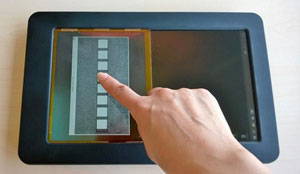New Tech Brings Sensations to Touch Screens
Microsoft researcher Hong Tan specializes in computer haptics and is currently developing software and hardware that will add tactile sensations to touch-based devices. That could mean feeling a "click" when touching a button on a screen, or feeling the weight of folders as you move them across the Home screen. Sure, this type of feedback isn't really needed, but it could make for a more immersive touch experience.
"With sight alone, most people are perfectly fine interacting with computing devices today, but how much more efficiently, how much more enjoyably, can we interact with computers? How much more accessible can we make them? We won't know until this becomes taken for granted," Tan said on Tuesday.
According to Microsoft Research, Tan worked at the Purdue University facility until 2011 when she joined Microsoft. She is now working on emulating texture and traction on glass surfaces using electrovibration and key-click feedback on flat keyboards. Unlike current devices that provide a two-dimensional experience, these will provide a "multisensory experience."
"In the case of vibration feedback, for example, it involves electronic engineering and mechanics, as well as knowledge about human sensitivity to various vibration frequencies," Microsoft Research said in a recent post. "In the case of haptic keyboards, the key-click feedback is not just symbolic or abstract: It simulates the feeling of pressing a key."
Tan has created a Human-Computer Interaction group that has developed several prototypes that produce haptic keyboard feedback. She had already shown that haptic keyboards are far more superior than the typical on-screen keyboard (pdf). Now the team is working to emulate sticky and smooth sensations through electrovibrations.
In a picture provided in the report (shown above), an electrostatic haptics prototype provides two "surfaces" on a touch screen: a gray area that feels sandpaper-rough to the finger, and a dotted line that has a notched texture for scrolling.
The report said that Tan is now working with the Accessibility group at Microsoft. This group is providing her with information about how blind people actually read maps, how they navigate a space, and so on. She's also working with other Microsoft designers about how haptics feedback will help improve their product, and how haptics will improve interactions between family members located over great distances.
Get Tom's Hardware's best news and in-depth reviews, straight to your inbox.
Follow Kevin Parrish @exfileme. Follow us @tomshardware, on Facebook and on Google+.

Kevin Parrish has over a decade of experience as a writer, editor, and product tester. His work focused on computer hardware, networking equipment, smartphones, tablets, gaming consoles, and other internet-connected devices. His work has appeared in Tom's Hardware, Tom's Guide, Maximum PC, Digital Trends, Android Authority, How-To Geek, Lifewire, and others.
-
Merry_Blind YESSS finally!!!! This is what has always been missing from touch interfaces: tactile feedback.Reply -
f-14 meh, unless you're blind you don't need this, all you need is some processing power devoted from some of those unused cores to make more animated visual acknowledgement of the touch interface, sound acknowledgement would be nice also.Reply
haptic feedback is only needed for the blind.
realistically microsoft should be working on voice command instead of wasting time with irrelevant to non blind people tech.
